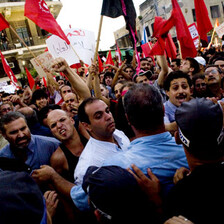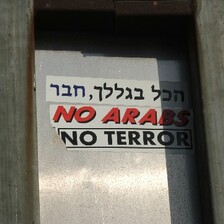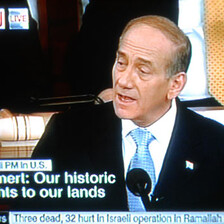The Electronic Intifada 29 May 2006
Ehud Olmert’s “convergence plan,” detailed in an interview with Karby Leggett of The Wall Street Journal (April 12, 2006), has major ramifications for Israel-Palestine, regional peace and the international community. Olmert talks of “a large pullout from parts of the occupied West Bank within the next 18 months.” He plans “to evacuate as many as 70,000 settlers…which could cost more than $10 billion - while annexing large chunks of disputed Palestinian territory. The goal … is to establish permanent, internationally recognized borders that will ensure Israel retains its Jewish majority for decades to come. Though he expects to carry out the plan without Palestinian input, he believes it … could lead to the establishment of a Palestinian state and a negotiated peace settlement someday.”
Of the 250,000 Israeli citizens living in over a hundred West Bank settlements, (not counting 200,000 settlers in occupied East Jerusalem), only one-third will face evacuation, says Leggett. “Many may be offered relocation to the large settlement blocs Israel plans to retain. … Perhaps the most sensitive issue will be the question of Jerusalem. Palestinians claim the city as their future capital and say that must be reflected in any resolution to the Mideast’s core conflict. The U.S. has generally supported the Palestinian position during previous peace negotiations.”
Olmert ruled out sharing political control of Jerusalem and its holy sites: “Dividing Jerusalem will not bring peace, only more fighting,” he said.
A glance at Map 1 shows Jerusalem sprawled midway between the northern and southern parts of the West Bank. To its west is Israel. To its east, the Judaean Desert -descends to the Jordanian border, dominated by the Maale Adumim settlement bloc. Contact between the northern and southern cantons - like contact with Gaza - will depend on Israel’s good graces. It is unlikely, to say the least, that the result will be the “viable Palestinian state” touted repeatedly by U.S. President George W. Bush since June 2002, when he introduced his “Road Map to Peace” and the Bush Vision.
The Economist, in an April 12, 2006 editorial on Jerusalem, disagrees with Olmert: “No peace is possible unless the city remains accessible, from both its east and west. At the very least, during this period of relative calm, Israel must keep its barrier as open as possible. Sealing in and cutting off the Palestinians of Jerusalem will only make another descent into violence more likely.”
Leggett, in The Wall Street Journal article, comments on the expected Palestinian response to Olmert’s plan: “Anger also could rise in the West Bank and Gaza, where many Palestinians see the pullout as an attempt by Israel to avoid negotiations and impose its will. Already, senior leaders of the militant Islamist organization Hamas … have called Mr. Olmert’s plan a ‘declaration of war.’”
Olmert mentions a $10 billion price tag to his “convergence” plan, and implies that Washington will fund it. If the U.S. complies, writes Leggett, it “will likely be seen throughout the Middle East as assisting Israel’s bid to take permanent control of large settlement blocs and Jerusalem. The fear is that this would add to regional anger toward the U.S., complicating efforts to stabilize Iraq and promote democracy in other countries.”
Olmert’s convergence plan is intended to establish final borders, already visible in the form of the Wall. In their report “Under the Guise of Security,” [1] Israeli human-rights organizations, BIMKOM and B’Tselem, detail how the Wall has been erected to create prime real estate and hasten expansion of the settlements (which are illegal under international law). Olmert’s agenda highlights what peace activists have long been saying: the Wall is a long-term political border, rather than the “temporary security installation” claimed by Israeli military planners, when testifying at Supreme Court hearings.
As to Jerusalem, B’Tselem states: “The decision to run the barrier along the municipal border, and the weak arguments given to explain that decision, lead to the conclusion that the primary consideration was political: the unwillingness of the government to pay the political price for choosing a route that will contradict the myth that ‘unified Jerusalem is the eternal capital of Israel.’” [2]
In Greater Jerusalem, the settlement bloc of Maale Adumim and the E-1 development (Map 2) have huge strategic impact on Palestinian viability. Jeff Halper of The Israeli Committee Against House Demolitions (“ICAHD”) writes: “Since 40% of the Palestinian economy revolves around Jerusalem and its tourist-based economy, the E-1 plan effectively cuts the economic heart out of any Palestinian state, rendering it nothing more than a set of non-viable Indian reservations.”
E-1 is the only undeveloped tract of land immediately east of Jerusalem, and was illegally annexed to Maale Adumim in the mid-90s. Israel is developing it and surrounding it with the Wall, so that the Maale Adumim bloc will completely divide the West Bank and prevent Palestinian contiguity. Olmert says development of E-1 will go ahead, despite the disapproval of the U.S. State Department. Real estate boards there already proclaim “Nof Adumim.”
Maale Adumim, too, maintains frantically defiant growth. In a Real Estate supplement of Haaretz (Spring 2006) we read: “Maale Adumim continues to mushroom: The award winning ‘model town’, just ten minutes by car outside Jerusalem, just keeps on growing. This is the community - now approaching the 40,000 mark - where … a large shopping mall, four swimming pools, top quality religious and secular schools and communal facilities [are] coming up in a few months: 76 totally new units, coming off the drawing board and into an eagerly awaiting market.”
The building of 3,500 units on E-1 also precludes natural expansion by Palestinians of East Jerusalem onto the last remaining open land. Likewise, the Jewish settlement of Pisgat Ze’ev in the city’s north isolates Jerusalem from Ramallah, just as Har Homa (“the mountain wall”) settlement in the south, fortified by the Wall, damages the vital Bethlehem-East Jerusalem-Ramallah economic salient. Where the Palestinian areas are concerned, de-development is the name of Israel’s game.
The United Nations Office for the Coordination of Humanitarian Affairs (“OCHA”) issued a report in February 2006: Access to Jerusalem - New Military Order Limits West Bank Palestinian Access, [3] stating: “As the Barrier nears completion around Jerusalem, recent Israeli military orders further restrict West Bank Palestinian pedestrian and vehicle access into Jerusalem. These orders integrate the Barrier crossing regime into the closure system.” The report details humanitarian impacts on Palestinian hospitals in East Jerusalem (Augusta Victoria has closed 30% of its beds, Makassed 40%), saying that the new military orders, “constitute an additional tightening of Palestinian movement. Prior to the institution of the closure policy in 1993 which limited Palestinian access into Jerusalem, [it was] the economic, political, medical, religious, educational and cultural centre for Palestinian lives in the West Bank. The new military order combined with the Barrier completion will physically seal off Jerusalem from the West Bank: accessing Jerusalem will become indistinguishable from accessing Israel. … Approximately 60,000 Palestinians cross through the checkpoints daily - to and from their destinations. Neighbourhoods are separated from each other; educational, medical and economic ties have been fractured. … The city is becoming largely isolated from Palestinian communities in the West Bank.”
Security is always a useful alibi in a militarised society, where a political agenda may be served by inciting fear and promoting violence. Amir Cheshin (Mayor Teddy Kollek’s adviser on Arab Affairs until 1993), in Municipal Policies in Jerusalem: An Account from Within (Passia, 1998), describes the policy in the 1970s: “The main idea behind the land appropriation was to isolate East Jerusalem from the West Bank and to create a ring of Jewish neighbourhoods as an urban buffer between the two.” The Wall in Jerusalem, then, becomes a fulfilment of longstanding policy. No surprise therefore that the planned route around the city, 75 kilometres long, has only 5 kilometres on the “Green Line” (the 1949 Armistice Line).
All this represents basic strategy: Israel intends to withdrawal unilaterally from minor areas in order to keep geopolitically strategic ones, especially Jerusalem and other blocs. The intention has always been to undermine Palestinian viability while controlling demographics. Jeff Halper’s “matrix of control” is another name for this strategy. [4] It is no coincidence that the Wall has grabbed the best farmland and most of the water (“Security or Greed?” asks Avraham Tal in Haaretz, April 20), and has destroyed all economic interfaces and market towns (Nazlat Issa, Qalqilya, Mas’ha, A-Ram, Abu Dis and Al-Azariya), while Israel has marginalised the Palestinian transport system.
The political die has been cast, and Israel is officially entering the world community as an Apartheid state, with unilaterally-determined, colonialist borders set in concrete, delineating a non-viable, truncated Bantustan version of Palestine, which will be trapped and stifled in the bear hug of Big Brother Israel. All of which is being accomplished with American and European complicity, contrary to international law and human rights.
Whilst it may be easy for the pro-Israel lobby to cry “Anti-Semite!” one hopes world leaders will wake up and recognize their own denial of facts that have long been staring them in the face, while peace activists have gone blue repeating the warnings.
The past 38 years of occupation have been used to put belligerent facts on the ground - facts which could be reversed at a price, if the political will exists. But Ariel Sharon’s coup de grace, the Bush-Sharon Letter of Understanding (April 2004), has granted Israel carte blanche to avoid peace negotiations leading to a viable Palestinian state. Since “redeploying” from Gaza, Israel has neither implemented its commitments to Condoleezza Rice (no Gazans work here or travel to the West Bank) nor held negotiations with Abu Mazen. It has not enacted any trust-building measures at all. Its soldiers continue with impunity to kill Palestinian civilians on a daily basis. While the latest suicide attack, on April 17 in Tel Aviv, has traumatized Israel yet again, we should not forget, as Amnesty International reminds us in its press release condemning the bombing: “Yesterday’s attack brings to 15 the number of Israeli civilians killed by Palestinian armed groups since the beginning of this year. In the same period Israeli forces killed some 75 Palestinians, many of them unarmed and including more than 15 children.”
To quote Dov Weisglass (an adviser to Ariel Sharon and now to Olmert), Israel has “put the Palestinians on a diet, but not to make them die of hunger.” It has deliberately weakened and undermined Abu Mazen. The Saudi Initiative, offering regional integration and full peace in exchange for the ‘67 borders, has been ignored. Completely. Twice.
The intention is to make the Palestinians force Hamas to change its attitude towards Israel as part of the broader, perpetual intention of forcing the Palestinians to accept the lot that Israel assigns them. Hamas is willing to recognize Israel beyond the 1967 borders on a long-term unofficial basis, in exchange for an extended ceasefire - a ceasefire it has maintained for over a year, in spite of all. But the 1967 borders are precisely the anathema that unilateralism intends to escape. Those borders, which would cede the Palestinians 22% of historic Palestine, just might give them, including all those returning refugees, a chance for real statehood and a decent life.
Jailed Fatah leader Marwan Barghouti said of Olmert’s plan (in a YNet interview on April 15): “This plan attempts to eliminate the intention to establish an independent Palestinian state. … [I]t is impossible to achieve trust before the occupation ends and we establish an independent state with Jerusalem as its capital, the refugees will return, all prisoners will be released, and our people will enjoy freedom and independence.” It is the Palestinians, he said, who can’t find a partner for peace. He accuses Israel of using the Hamas victory as a convenient pretext, “because negotiations have been paralyzed for six years at least, and Israel even assassinated President Yasser Arafat, even though he complied with all the international conditions for peace.”
Again, The Economist: “If the barrier really is just for security, Israel … could stop the incessant encroachment of Jewish neighbourhoods into Palestinian areas. But so far its main concern seems to be to ensure that this conquest of Jerusalem be the last one.”
Next year in Jerusalem? A Jerusalem where the Old City already houses 41 settlements, with plans to develop 33 more housing units near Herod’s Gate? A Jerusalem with almost as many settlers as Palestinians (200,000 : 230,000)? A Jerusalem where ethnic transfer is the name of the game? Where the values are pride and hubris, greed, lust, fear and covetousness? A Jerusalem which secular Israelis have increasingly abandoned? A Jerusalem where separation is enforced and co-existence nullified?
A ten year old child once wrote about the hungry of the world: “We have got to understand that they dream our dreams and we dream theirs.” Her dream then was to end world hunger by the year 2000. An Israeli bulldozer killed her, three years ago. When she died, her mother wrote: “Rachel was filled with love and a sense of duty to her fellow man, wherever they lived. And, she gave her life trying to protect those that are unable to protect themselves.”
So who, now, will stand up for a Free Palestine? The choice is now. Ongoing conflict and official apartheid, or finally, once and for all, a real peace. Finally, a viable Palestine. It’s our choice.
Angela Godfrey-Goldstein is Action Advocacy Officer for the Israeli Committee Against House Demolitions and lives in Jerusalem. Prior to immigration in 1981, she lived in Johannesburg and worked in Soweto. Recently she spent four years working in Sinai, Egypt. This article first appeared in Challenge Magazine under the title “The Choice is Now”, and is reprinted with permission.
Endnotes
1. www.reliefweb.int/library/documents/2005/btselem-opt-31dec.pdf
2. www.btselem.org/english/separation_barrier/jerusalem.asp
3. www.humanitarianinfo.org/opt/docs/UN/OCHA/ochaHU0206_En.pdf
4. See “The Matrix of Control”
Related Links





